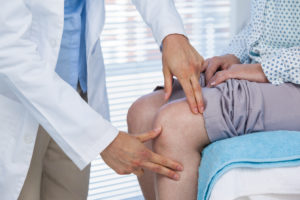Study explores the optimal time to measure glucose levels after TJA

A periprosthetic joint infection (PJI) after total joint arthroplasty (TJA) is often a devastating experience for a patient, involving a long treatment process that dramatically reduces a patient’s quality of life.
While the rates of PJI following TJA are low—ranging from 2 to 5 percent for knee replacements and 1 to 3 percent for hip replacements—hundreds of thousands of infections still occur annually, causing a tremendous burden to patients and providers.
Since hyperglycemia is a major contributor to PJI, it is common practice to measure postoperative glucose levels, typically on the morning after surgery. However, the optimal time to draw glucose levels to evaluate for non-postprandial hyperglycemia after TJA has been previously unknown.
Postoperative night: the most sensitive time for detecting hyperglycemia
“Our study found glucose values may be the most sensitive for detecting hyperglycemia in both diabetic and non-diabetic patients on the night after the operation, between 8:45 to 9:15 PM (3+ hours after dinner),” said Antonia F. Chen, MD/MBA, a hip and knee replacement surgeon, who recently joined the Department of Orthopaedic Surgery at Brigham and Women’s Hospital as the Director of Research, Arthroplasty Services.
Dr. Chen’s retrospective, single institution study compared postoperative glucose levels in 314 primary, elective TJA patients, from September 2017 to September 2018. Blood glucose levels were collected at the following four time points:
- Immediately preoperative (fasting)
- Immediately postoperative (fasting)
- Postoperative day (POD) 0 night (between 4:30 to 5:30 PM before dinner, and between 8:45 to 9:15 PM 3+ hours after dinner)
- POD1 morning (fasting)
Hyperglycemia was defined as glucose≥126 mg/dl, and diabetes was defined as those with a hemoglobin A1c (HbA1c) ≥6.5% or a documented diagnosis of diabetes.
The results of the study were presented on November 11th at the 2018 American Association of Hip and Knee Surgeons meeting. The research was conducted in collaboration with Nathan Varady, BS, Pierre‐Emmanuel Schwab, MD, and Todd Jones, BS.
A significant contributor to this study was Wolfgang Fitz, MD, an orthopaedic surgeon who specializes in the surgical treatment of knee arthritis at Brigham and Women’s Faulkner Hospital. A focus of Dr. Fitz’s clinical research has been to determine the optimal marker for glucose control to reduce postoperative complications.
Using a low-carbohydrate diet to regulate sugar in the perioperative period
A concerning finding in the study was that the majority of the TJA patients were hyperglycemic postoperatively. In order to regulate glucose in these patients and potentially avoid postoperative complications, Dr. Chen and her colleagues used methods to help keep patients euglycemic after meals.
One of these methods included the use of a hyperglycemic protocol, where patients were put on a low-carbohydrate diet. The investigators also experimented with the use of a ketogenic diet to regulate hyperglycemia. Ongoing studies will evaluate how dietary changes impact glucose levels and joint infection rates after total joint arthroplasty.
According to Dr. Chen, the results suggest that physicians should be checking glucose levels more regularly to ensure that their patients aren’t hyperglycemic. She noted that glucose isn’t the only culprit and that physicians should also routinely check hemoglobin A1c, fructosamine, and insulin levels. Other laboratory markers and continuous glucose monitoring may prove to be better markers of postoperative hyperglycemia.
“The orthopaedic surgeons at the Brigham are constantly investigating, implementing and refining surgical protocols to provide the best care for our patients. We want to conduct practice-changing research and improve patient care with cutting-edge, evidenced-based medicine,” said Dr. Chen.